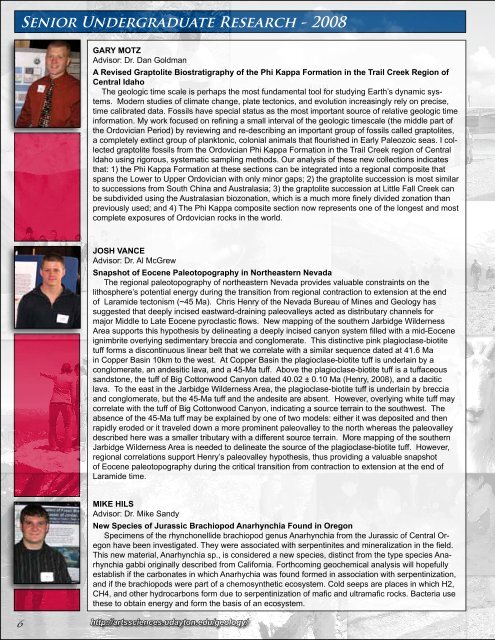View this issue (pdf) - University of Dayton
View this issue (pdf) - University of Dayton
View this issue (pdf) - University of Dayton
You also want an ePaper? Increase the reach of your titles
YUMPU automatically turns print PDFs into web optimized ePapers that Google loves.
Senior Undergraduate Research - 2008<br />
GARY MOTZ<br />
Advisor: Dr. Dan Goldman<br />
A Revised Graptolite Biostratigraphy <strong>of</strong> the Phi Kappa Formation in the Trail Creek Region <strong>of</strong><br />
Central Idaho<br />
The geologic time scale is perhaps the most fundamental tool for studying Earth’s dynamic systems.<br />
Modern studies <strong>of</strong> climate change, plate tectonics, and evolution increasingly rely on precise,<br />
time calibrated data. Fossils have special status as the most important source <strong>of</strong> relative geologic time<br />
information. My work focused on refining a small interval <strong>of</strong> the geologic timescale (the middle part <strong>of</strong><br />
the Ordovician Period) by reviewing and re-describing an important group <strong>of</strong> fossils called graptolites,<br />
a completely extinct group <strong>of</strong> planktonic, colonial animals that flourished in Early Paleozoic seas. I collected<br />
graptolite fossils from the Ordovician Phi Kappa Formation in the Trail Creek region <strong>of</strong> Central<br />
Idaho using rigorous, systematic sampling methods. Our analysis <strong>of</strong> these new collections indicates<br />
that: 1) the Phi Kappa Formation at these sections can be integrated into a regional composite that<br />
spans the Lower to Upper Ordovician with only minor gaps; 2) the graptolite succession is most similar<br />
to successions from South China and Australasia; 3) the graptolite succession at Little Fall Creek can<br />
be subdivided using the Australasian biozonation, which is a much more finely divided zonation than<br />
previously used; and 4) The Phi Kappa composite section now represents one <strong>of</strong> the longest and most<br />
complete exposures <strong>of</strong> Ordovician rocks in the world.<br />
JOSH VANCE<br />
Advisor: Dr. Al McGrew<br />
Snapshot <strong>of</strong> Eocene Paleotopography in Northeastern Nevada<br />
The regional paleotopography <strong>of</strong> northeastern Nevada provides valuable constraints on the<br />
lithosphere’s potential energy during the transition from regional contraction to extension at the end<br />
<strong>of</strong> Laramide tectonism (~45 Ma). Chris Henry <strong>of</strong> the Nevada Bureau <strong>of</strong> Mines and Geology has<br />
suggested that deeply incised eastward-draining paleovalleys acted as distributary channels for<br />
major Middle to Late Eocene pyroclastic flows. New mapping <strong>of</strong> the southern Jarbidge Wilderness<br />
Area supports <strong>this</strong> hypothesis by delineating a deeply incised canyon system filled with a mid-Eocene<br />
ignimbrite overlying sedimentary breccia and conglomerate. This distinctive pink plagioclase-biotite<br />
tuff forms a discontinuous linear belt that we correlate with a similar sequence dated at 41.6 Ma<br />
in Copper Basin 10km to the west. At Copper Basin the plagioclase-biotite tuff is underlain by a<br />
conglomerate, an andesitic lava, and a 45-Ma tuff. Above the plagioclase-biotite tuff is a tuffaceous<br />
sandstone, the tuff <strong>of</strong> Big Cottonwood Canyon dated 40.02 ± 0.10 Ma (Henry, 2008), and a dacitic<br />
lava. To the east in the Jarbidge Wilderness Area, the plagioclase-biotite tuff is underlain by breccia<br />
and conglomerate, but the 45-Ma tuff and the andesite are absent. However, overlying white tuff may<br />
correlate with the tuff <strong>of</strong> Big Cottonwood Canyon, indicating a source terrain to the southwest. The<br />
absence <strong>of</strong> the 45-Ma tuff may be explained by one <strong>of</strong> two models: either it was deposited and then<br />
rapidly eroded or it traveled down a more prominent paleovalley to the north whereas the paleovalley<br />
described here was a smaller tributary with a different source terrain. More mapping <strong>of</strong> the southern<br />
Jarbidge Wilderness Area is needed to delineate the source <strong>of</strong> the plagioclase-biotite tuff. However,<br />
regional correlations support Henry’s paleovalley hypothesis, thus providing a valuable snapshot<br />
<strong>of</strong> Eocene paleotopography during the critical transition from contraction to extension at the end <strong>of</strong><br />
Laramide time.<br />
MIKE HILS<br />
Advisor: Dr. Mike Sandy<br />
New Species <strong>of</strong> Jurassic Brachiopod Anarhynchia Found in Oregon<br />
Specimens <strong>of</strong> the rhynchonellide brachiopod genus Anarhynchia from the Jurassic <strong>of</strong> Central Oregon<br />
have been investigated. They were associated with serpentinites and mineralization in the field.<br />
This new material, Anarhynchia sp., is considered a new species, distinct from the type species Anarhynchia<br />
gabbi originally described from California. Forthcoming geochemical analysis will hopefully<br />
establish if the carbonates in which Anarhychia was found formed in association with serpentinization,<br />
and if the brachiopods were part <strong>of</strong> a chemosynthetic ecosystem. Cold seeps are places in which H2,<br />
CH4, and other hydrocarbons form due to serpentinization <strong>of</strong> mafic and ultramafic rocks. Bacteria use<br />
these to obtain energy and form the basis <strong>of</strong> an ecosystem.<br />
6<br />
http://artssciences.udayton.edu/geology/
















